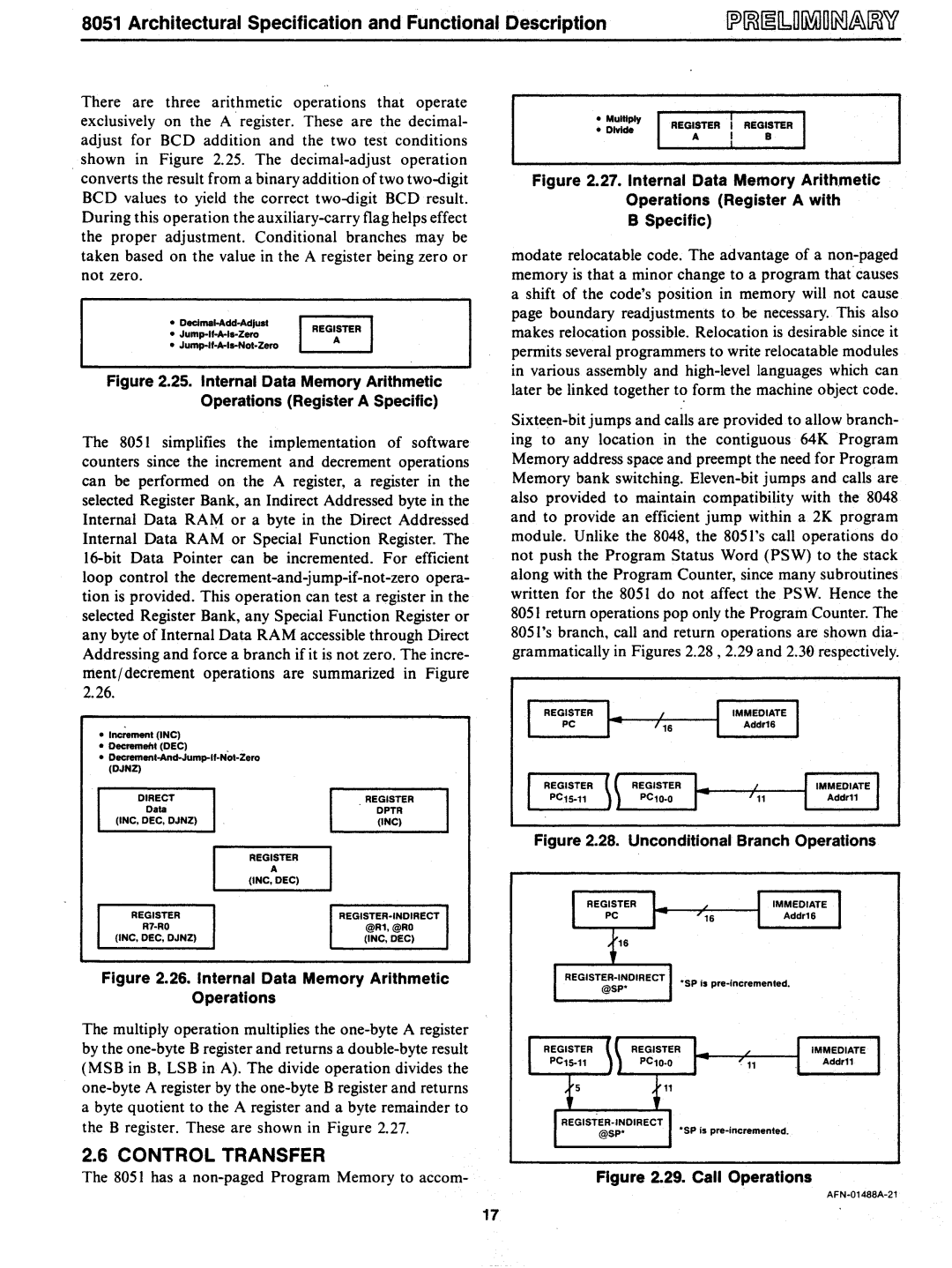8051 Architectural Specification and Functional Description
There are three arithmetic operations that operate exclusively on the A· register. These are the decimal- adjust for BCD addition and the two test conditions shown in Figure 2.25. The decimal-adjust operation converts the result from a binary addition of two two-digit BCD values to yield the correct two-digit BCD result. During this operation the auxiliary-carry flag helps effect the proper adjustment. Conditional branches may be taken based on the value in the A register being zero or not zero.
• Declmal-Add-Adjust [:EJ
• Jump-lf-A-ls.ZeroREG~TER
• Jump-I'·A-Is-Nol·Zero
Figure 2.25. Internal Data Memory Arithmetic Operations (Register A Specific)
::': r REGISTERT REGISTER 1 A I B
Figure 2.27. Internal Data Memory Arithmetic
Operations (Register A with
B Specific)
modate relocatable code. The advantage of a non-paged memory is that a minor change to a program tha( causes a shift of the code's position in memory will not cause page boundary readjustments to be necessary. This also makes relocation possible. Relocation is desirable since it permits several programmers to write relocatable modules in various assembly and high-level languages which can later be linked together to form the machine object code.
The 805 I simplifies the implementation of software counters since the increment and decrement operations can be performed on the A register, a register in the selected Register Bank, an Indirect Addressed byte in the Internal Data RAM or a byte in the Direct Addressed Internal Data RAM or Special Function Register. The 16-bit Data Pointer can be incremented. For efficient loop control the decrement-and-jump-if-not-zero opera- tion is provided. This operation can test a register in the selected Register Bank, any Special Function Register or any byte of Internal Data RAM accessible through Direct Addressing and force a branch if it is not zero. The incre- ment Idecrement operations are summarized in Figure
Sixteen-bit jumps and calls are provided to allow branch- ing to any location in the contiguous 64K Program Memory address space and preempt the need for Program Memory bank switching. Eleven-bit jumps and calls are also provided to maintain compatibility with the 8048 and to provide an efficient jump within a 2K program module. Unlike the 8048, the 8051's call operations do not push the Program Status Word (PSW) to the stack along with the Program Counter, since many subroutines written for the 8051 do not affect the PSW. Hence the 8051 return operations pop only the Program Counter. The 8051 's branch, call and return operations are shown dia- grammatically in Figures 2.28 , 2.29 and 2.3f> respectively.
2.26.
•Increment (INC)
•Decremeilt (DEC)
•Decremenl-And.Jump-tf-Nol-Zero (DJNZ)
DIRECT
Dala
(INC, DEC, DJNZ)
REGISTER
A
(INC, DEC)
REGISTER
R7-RO
(INC, DEC, DJNZ)
REGISTER
. DPTR (INC)
REGISTER-INDIRECT
@R1,@RO (INC, DEC)
REGplSCTER 1"'"4e-_-I-(~_--I~I_MM_E_D_'A_:r_E,.j
_/16_ Addr16
11
Figure 2.28. Unconditional Branch Operations
16
Figure 2.26. Internal Data Memory Arithmetic Operations
The mUltiply operation multiplies the one-byte A register by the one-byte B register and returns a double-byte result (MSB in B, LSB in A). The divide operation divides the one-byte A register by the one-byte B register and returns a byte quotient to the A register and a byte remainder to the B register. These are shown in Figure 2.27.
2.6 CONTROL TRANSFER
The 805 I has a non-paged Program Memory to accom-
17
. 11
*SP is pre..incremented.
Figure 2.29. Call Operations
AFN-Ol488A-21

